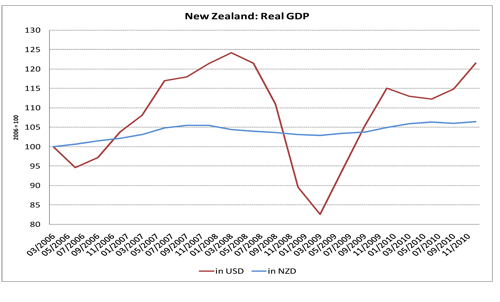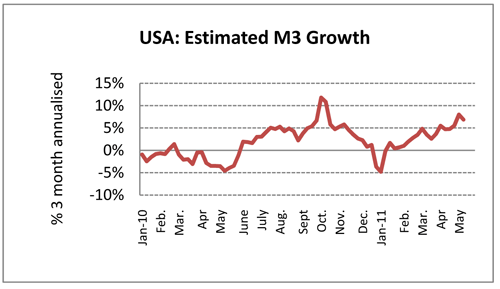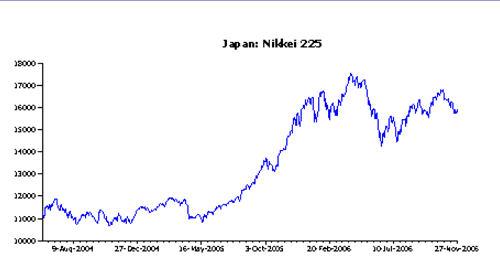Tyndall Commentary: Why Markets Are Not Reflecting The Economy
If there is one feature that perhaps stands out most within financial and even currency markets at present is the chasm that appears to have opened between the generally robust performance of asset markets and the rather more equivocal performance of the real economy.
Tuesday, June 7th 2011, 10:25AM
by Andrew Hunt
In many ways, New Zealand represents a prime example of this: the currency has appreciated by almost 50% since early 2009 but the economy measured in NZD has barely grown over the same period - it is almost as though there is a disconnect forming between the financial and real worlds.
 Of course, this disparity in behavior between the real and financial sectors is by no means unique to New Zealand. Clearly, financial markets have generally prospered over the last nine months despite the fact that, in most countries, we are finding signs of a mild stagflation appear as not only reported growth slows but core inflation rates also become notably elevated. In practice, we would argue that these two factors of slowing growth and rising inflation are inexorably intertwined, in that the higher inflation rates are so eroding household real incomes - and in many cases corporate profits as well - that real expenditure growth is falling by the wayside, not that we are that convinced there was much of a recovery in the global economy during 2010 to begin with....
Of course, this disparity in behavior between the real and financial sectors is by no means unique to New Zealand. Clearly, financial markets have generally prospered over the last nine months despite the fact that, in most countries, we are finding signs of a mild stagflation appear as not only reported growth slows but core inflation rates also become notably elevated. In practice, we would argue that these two factors of slowing growth and rising inflation are inexorably intertwined, in that the higher inflation rates are so eroding household real incomes - and in many cases corporate profits as well - that real expenditure growth is falling by the wayside, not that we are that convinced there was much of a recovery in the global economy during 2010 to begin with....
Indeed, it is becoming increasingly apparent that much of last year's economic growth (particularly, but not exclusively, in the West) now appears either simply ‘arithmetic' (i.e. the unwinding of previous intense destocking phases and 2008-9 era production dislocations) or the result of what have already proved to have been unsustainable fiscal policy actions. Consequently, far from appearing ‘V shaped', the global recovery is beginning to look decidedly more ‘L shaped' at this juncture, with last year's ‘highs' now apparently simply the result of specific factors that are no longer with us, such as last year's monster US fiscal transfers to the household sector that implicitly financed much of the US growth in the closing stages of the year. In effect, we are suggesting that it was not the periods of disappointing growth during 2010 that were ‘blips' in an otherwise upward trend but that the periods of strong growth later in the year were in fact upward blips on a much shallower trend.
Perhaps surprisingly to some, and we must admit a little uncomfortably from our own point of view, our tales of slowing growth in the Anglos, overheating in China and India and the deep-seated problems in the Euro Area (which clearly are now morphing from crisis to catastrophe) have not yet made us unduly negative on the outlook for financial markets. At present, we are still prepared to override the seemingly rather negative conclusions of our individual country-derived, more ‘bottom up' view of the global economy simply as a result of the continuing intense credit and capital flows boom within the global economy.
 While, at present, we do not have a definitive liquidity measure for the USA, we have used what data we do have in order to create an estimate for the former broad money aggregate that was known as M3 (a useful series that is no longer reported by the US statisticians), which we believe captures the flavour, if not the exact quantum, of current USD liquidity trends. Judged by this data, it seems clear just why markets appear to be made of Teflon currently when it comes to bad economic news, however seemingly severe the latter may be on any given day.
While, at present, we do not have a definitive liquidity measure for the USA, we have used what data we do have in order to create an estimate for the former broad money aggregate that was known as M3 (a useful series that is no longer reported by the US statisticians), which we believe captures the flavour, if not the exact quantum, of current USD liquidity trends. Judged by this data, it seems clear just why markets appear to be made of Teflon currently when it comes to bad economic news, however seemingly severe the latter may be on any given day.
Although we would not regard the series above as a particular Philosopher's Stone or even definitive measure of liquidity, what we would suggest based on this chart is that, at the present time, liquidity growth within the financial system is probably proceeding at about as rapid a pace as it is ever likely to be. This is an unsurprising conclusion given that USD wholesale borrowing rates for financial entities are somewhere between -0.1% and 0.1% at present (if you have the ‘right' collateral, such as Treasury bonds to offer the lender) and that the US banking system is apparently desperate to achieve asset growth through securities acquisitions and lending to financial sector entities, rather than through lending to real economy borrowers, a fact confirmed to us this week by a senior personality at HSBC.
Indeed, in a world in which bank capital is still perceived to be short and the US banks face a punitive effective interest rate if they themselves hold deposits as assets as a result of recent legislative changes, the banks are simply desperate to lend to financial entities in exchange for suitable collateral, such as US Treasury Bonds. Consequently, we feel that it is safe to suggest that we may be somewhere near the peak in the liquidity cycle since, from the point of view of the financial sector, it simply can't get much better than a combination of near zero rates + accommodative banks! The question still remains, though what shape will the peak have - will it be spiky or will it be more of a plateau?
We suspect that key to defining the shape of the "top of the cycle" will likely be the Federal Reserve's actions over the next few months. Although there is currently much talk of a QE3 policy, we would argue that the political backing for such a policy is not yet in existence and that the higher rates of commodity and core inflation now being recorded make it difficult for even the most dovish of central bankers to advocate yet another easing. Therefore, we believe that QE2 will simply come to an end over the next few weeks (in fact, it may effectively end in June as the FRB completes the vast majority of its bond purchase programme) and not be extended officially. Given the apparently soft state of the economy, though we would not expect the FRB to allow the size of its balance sheet to shrink (they tried that in 2010Q1 and markets didn't like it...) and we would also expect the central bank to continue to promise to leave short term interest rates low for a considerable period of time. For investors, this implicitly poses the question as to which will matter more for markets: the suspension of QE2 or the retention of the Zero Interest Rate Policy?
In an attempt to answer this question, we have reviewed our mid-2000s Japanese notes, since this was a period in which the Bank of Japan was involved in exiting its own QE regime. Our notes reveal that on a research trip to Japan in November 2005, we were informed that the BoJ was looking to exit its QE Regime and, according to the data, the BoJ did indeed begin to dispose of some of its holdings of government bonds shortly afterwards. Interestingly, we find that despite the fact that the government had already begun a severe tightening of its own fiscal stance in the previous June, the BoJ's exit from the JGB markets coupled with the adverse news flow from the BoJ (we doubt that we were the only visitors to the BoJ that were made aware of their intention to exit QE) led to a sharp selloff in bond prices. Indeed, prior to our visit, 10- Year JGBs had yielded 1.5% but within a few weeks yields had moved over 2%. We also find that Japanese equity prices, which had been particularly firm during the 2003-5 QE phase, continued to move higher even as the BoJ exited its QE Regime, although it should also be noted that they began to underperform many of their global peers in early 2006.
Based on this narrative of events, we can suggest that the end of the Japanese QE in 2005-6 was in some ways detrimental to the economy and that it was clearly detrimental to bond markets but its impact on equity prices is much less easy to discern - equity prices continued to rise modestly within the context of what was then still a global bull market in equities. In fact, Japanese equities did not peak until April 2006, when the BoJ apparently decided to exit its Zero Interest Rate Policy. Thereafter, equity prices in Japan became quite weak and the famed ‘Yen carry trade' also seemed to evaporate as Yen borrowing costs rose, to the obvious detriment of global risk markets (particularly the Emerging Markets) over the middle part of 2006.
 What can we learn from Japan's mid-2000s precedent? At first sight, we might suggest that any ending of QE in the USA could well be bad news for bonds, even if there is a fiscal tightening at the same time, but we can also suggest that equities may be able to ignore this development, at least for a few months and perhaps even until the Fed exits its own version of the Zero Interest Rate Policy and raises its interest rates.
What can we learn from Japan's mid-2000s precedent? At first sight, we might suggest that any ending of QE in the USA could well be bad news for bonds, even if there is a fiscal tightening at the same time, but we can also suggest that equities may be able to ignore this development, at least for a few months and perhaps even until the Fed exits its own version of the Zero Interest Rate Policy and raises its interest rates.
In fact, our conclusions from all of this would amount to the notion that the FRB's suspension of its QE should be a negative factor for bond prices but that equities and other risk markets such as the NZD should be able to weather the QE suspension event, at least initially, providing that US bond prices do not weaken too precipitously. If in the post QE2 world bonds do sell off sharply and in so doing imperil the underlying mechanisms of the latest financial sector credit boom, which itself is heavily based on the use of Treasury bonds as collateral, then we reserve the right to become a great deal more bearish. As we noted in our opening remarks, without the current liquidity boom the world economy would look a lot less healthy (the liquidity boom is simply hiding the fact that the Economic Emperor has no clothes) and we would also note that the balance of probability suggests that we are approaching some form of peak in the liquidity cycle. Therefore, if bonds do sell off sharply following the FRB's forthcoming suspension of its Quantitative Easing Policy and in so doing undermine the credit system through the effect of falling Treasury bond prices on collateral values, then we would suggest that havens should be sought and risk assets reduced.
Andrew Hunt International Economist London
| « Harbour Commentary: Tricky Turning Point | Harbour Commentary: The soft patch is behind us » |
Special Offers
Commenting is closed
| Printable version | Email to a friend |









